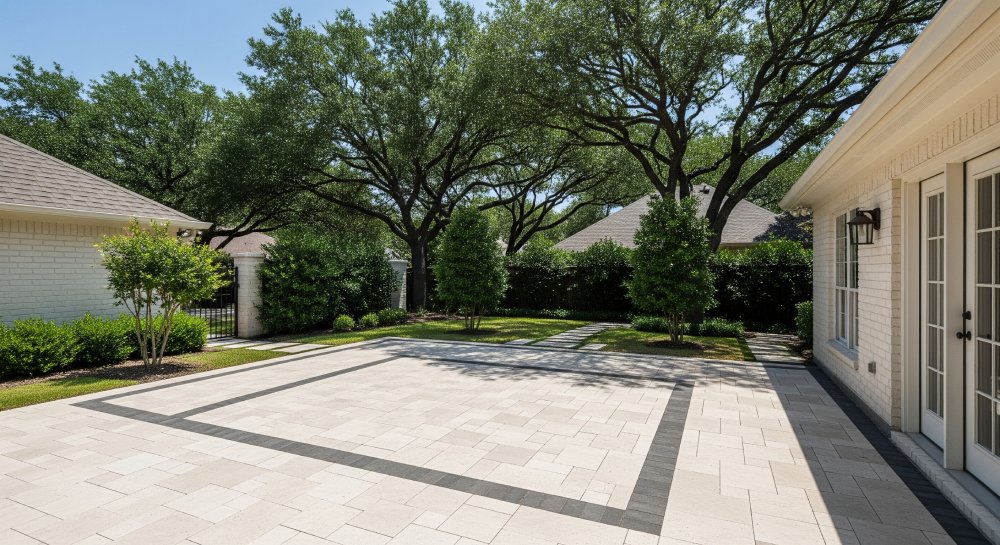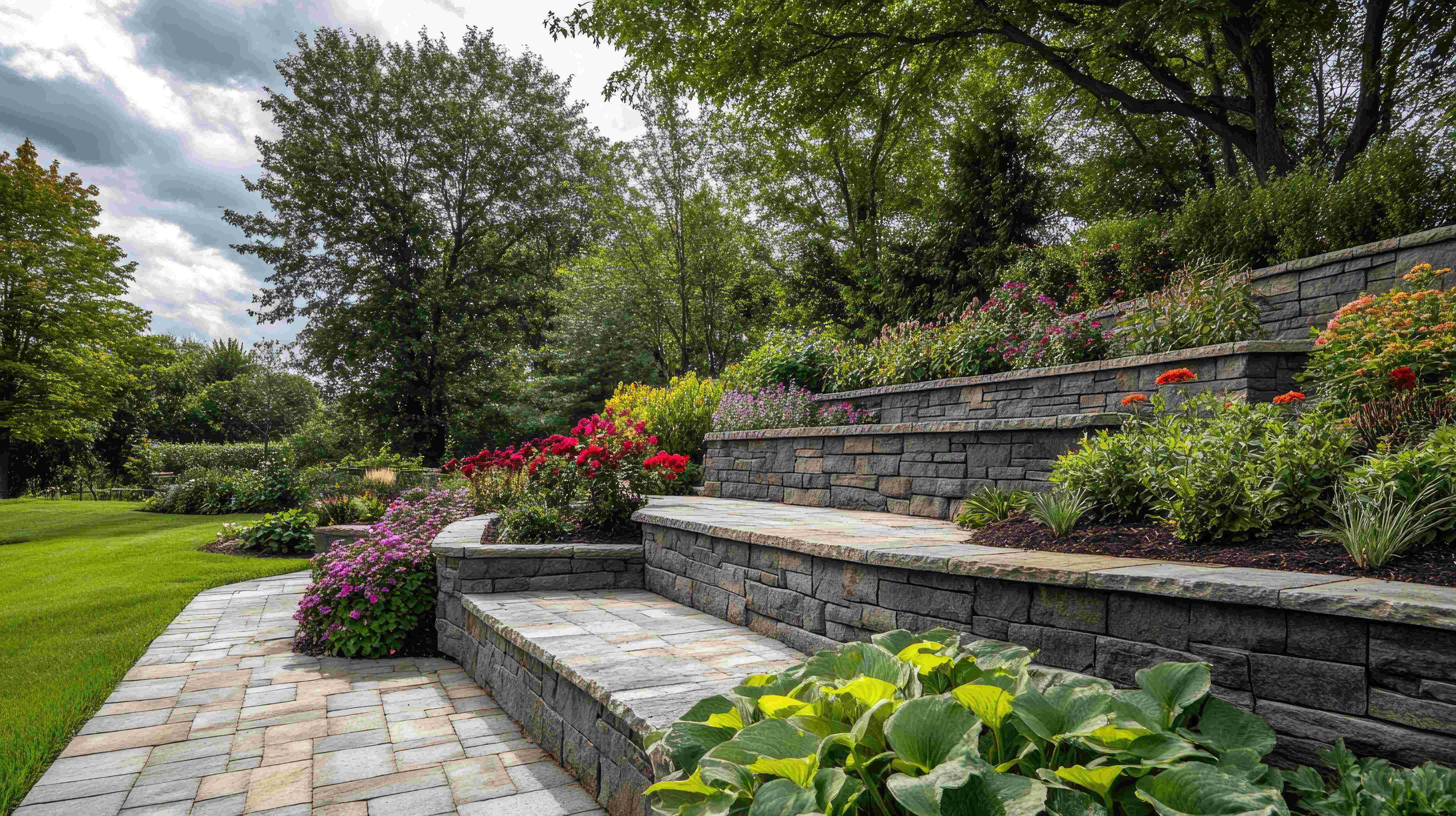
5 Best Retaining Wall Ideas for Stunning Backyard Design in 2025
5 Best Retaining Wall Ideas for Stunning Backyard Design in 2025
As a Landscape Design company with 10+ years of experience shaping outdoor environments, we can attest that retaining walls are among the most versatile elements in design. They solve practical challenges like soil retention while offering boundless opportunities for creativity. With 2025 approaching, we are excited to share five expertly crafted retaining wall ideas—along with some additional insights—to help you transform your property into a functional, aesthetically refined space. Let’s dive into the details.
Table of Contents
- What is a Retaining Wall?
- What Are Retaining Walls Made Of?
- #1 Make a Retaining Wall Flower Bed
- #2 Build a Terraced Garden Wall
- #3 Add a Stairway
- #4 Create a Living Wall
- #5 Include a Water Fountain
- Honorable Mentions: Small Retaining Wall Ideas
- Honorable Mentions: Sloped Backyard & Frontyard Ideas
What is a Retaining Wall?
At its core, a retaining wall is an engineered structure designed to restrain soil on sloped or uneven terrain, preventing erosion and stabilizing the landscape. Beyond this utilitarian purpose, it’s a foundational tool in landscape architecture. Properly designed, a retaining wall can delineate spaces, create usable flat areas, and serve as a striking visual anchor. The key to success lies in balancing structural integrity—accounting for soil pressure and drainage—with a design that enhances the site’s natural character.
What Are Retaining Walls Made Of?
Material selection is a cornerstone of effective retaining wall design, influencing durability, cost, and how well the structure integrates with its surroundings. As a landscape designer, we evaluate site conditions—soil composition, wall height, drainage needs—and the desired aesthetic before recommending a material. Below, we’ve detailed the most reliable options, each with unique strengths and considerations, to guide you in choosing the best fit for your 2025 project.
Concrete Blocks Retaining Wall
Concrete blocks, particularly interlocking segmental units, are a workhorse in retaining wall construction. Their uniform shape and built-in locking systems make them easy to install, even for complex curves or corners, while their strength supports walls up to 10 feet or higher with proper reinforcement. Available in finishes mimicking stone or sleek modern textures, they offer versatility for both contemporary and traditional landscapes. We recommend them for high-traffic areas or where precision is key, though they require a compacted gravel base and geogrid reinforcement for taller builds to manage lateral pressure.
Natural Stone Retaining Wall
Nothing rivals natural stone—limestone, sandstone, granite, or fieldstone—for an organic, enduring aesthetic in a retaining wall. Each piece’s unique shape and color creates a bespoke look that blends effortlessly with naturalistic plantings or rugged terrain. It’s a premium choice, best suited for dry-stack or mortared walls under 4 feet, as taller designs demand skilled masonry and significant footings to resist shifting. I often specify local stone to reduce transport costs and echo the site’s geology, ensuring proper drainage with a gravel backfill to prevent water buildup.
Timber Retaining Wall
Timber retaining walls, typically built with pressure-treated pine, cedar, or redwood, bring a warm, rustic charm that’s hard to replicate. They’re cost-effective and straightforward to construct, making them ideal for low walls (up to 3 feet) in casual garden settings. However, wood’s susceptibility to rot and insect damage means it needs a protective barrier—like a waterproof membrane—and excellent drainage to extend its lifespan. We advise clients to pair timber with bold plantings to offset its simplicity, though it’s less suited to wet climates or long-term structural demands.
Gabion Baskets Retaining Wall
Gabion baskets retaining walls, composed of wire mesh baskets filled with stones, offer a modern, industrial vibe with surprising flexibility. The fill—river rock, recycled concrete, or quarried stone—can be tailored to the site, while the open structure naturally promotes drainage, reducing hydrostatic pressure. They shine in low- to mid-height applications (up to 6 feet) and are relatively quick to assemble, though taller walls need anchoring or a wider base for stability. We’ve used gabions to striking effect in urban courtyards, where their texture contrasts beautifully with smooth paving or steel accents.
Brick Retaining Wall
Brick retaining walls bring a classic, refined look, especially in formal gardens or historic properties. Its small, modular size allows for tight curves and detailed patterns, and modern engineering bricks offer enhanced durability over traditional clay varieties. Best for walls under 3 feet due to its weight-bearing limits, brick requires a concrete footing and occasional weep holes for drainage. We recommend it for frontyard features or petite terraces, where its crisp lines elevate curb appeal—though it’s less practical for heavy-duty erosion control.
Poured Concrete Retaining Wall
For sheer strength, poured concrete retaining walls are unmatched, making them the choice for tall, load-bearing walls or urban sites with strict engineering demands. Reinforced with steel rebar and poured into custom forms, it can be textured, stained, or stamped to mimic stone or add visual interest. Its monolithic nature resists movement, but installation is labor-intensive and requires professional expertise—plus a robust drainage system to avoid cracking from water pressure. We reserve this for utilitarian projects or where a sleek, minimalist aesthetic is the goal.
Each of these materials offers distinct advantages, and the right one depends on your site’s specific needs—slope gradient, soil type, and exposure—paired with your stylistic vision. A well-chosen material ensures your retaining wall stands the test of time while enhancing the landscape’s character.
#1 Design a Retaining Wall Flower Bed
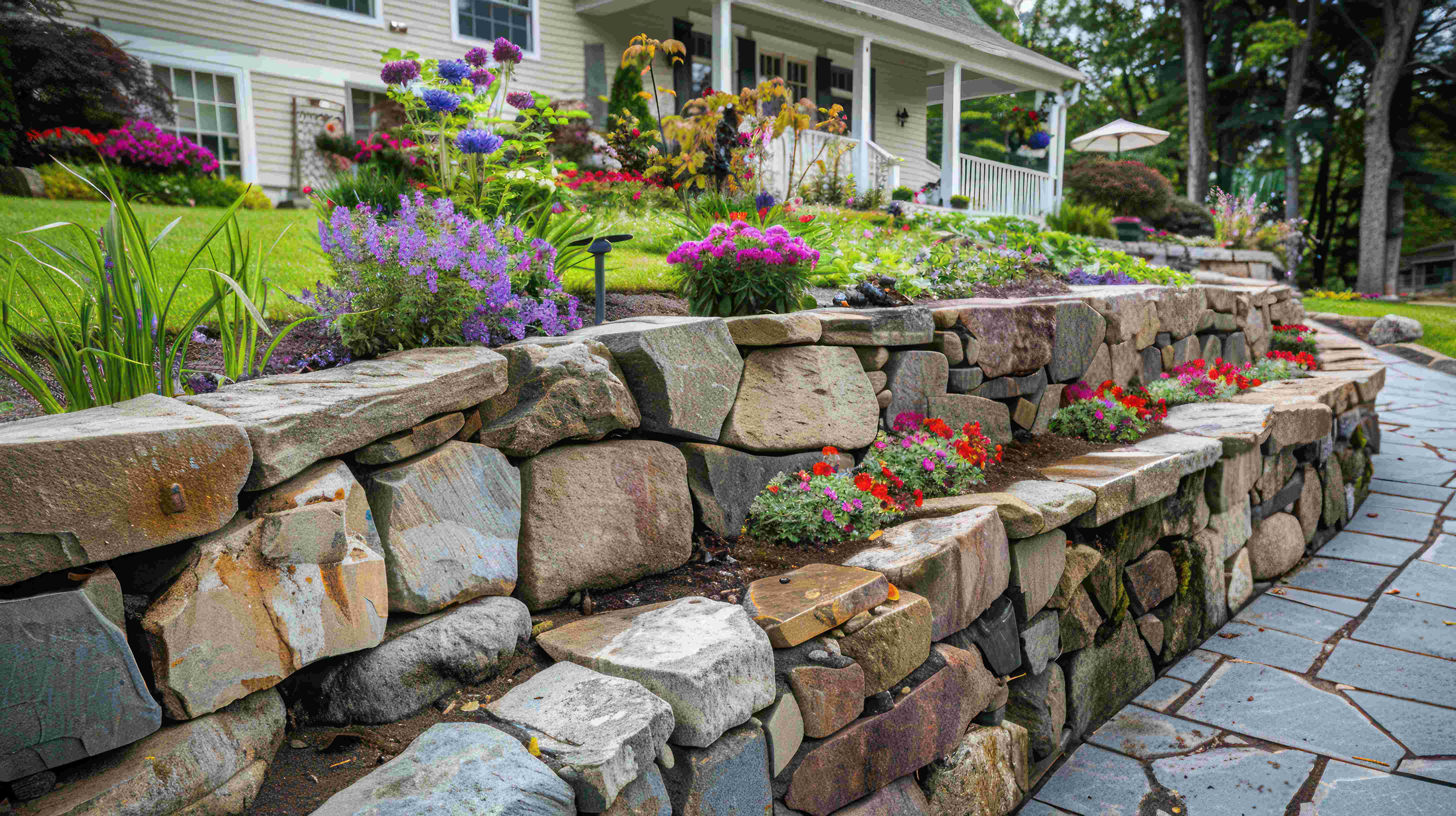
One of my go-to solutions for adding vibrancy to a landscape is a retaining wall flower bed. Construct a wall 12 to 24 inches high using stacked stone or concrete blocks, ensuring a slight backward lean (about 1 inch per foot of height) for stability. Backfill with a well-draining soil mix—50% topsoil, 30% compost, 20% sand works well—and cap it with a stone coping to prevent soil spillover. This elevated bed is perfect for showcasing plants with varying heights and textures: try drifts of lavender or salvia for color, anchored by ornamental grasses like miscanthus for structure. For drainage, install a perforated pipe at the base, wrapped in geotextile fabric to prevent clogging. This design not only controls erosion but also turns a utilitarian wall into a horticultural centerpiece, ideal for borders or tight spaces
#2 Opt for a Terraced Garden Retaining Wall

On steeply sloped sites, a terraced retaining wall system is often the most effective—and visually compelling—approach. Instead of a single, monolithic wall, we design a series of walls, typically 2 to 4 feet high each, spaced 4 to 6 feet apart horizontally, depending on the slope’s gradient. This creates a stepped profile, with each tier offering a flat planting or activity zone. Structurally, each wall needs a concrete footing (6 to 12 inches deep) and a 6-inch layer of compacted gravel behind it to manage water pressure—crucial for avoiding bulging or collapse. We’ve used this method to create layered gardens: one client grew a cutting garden on the lowest tier, vegetables mid-level, and a native meadow at the top. The terraces break up the slope’s mass, soften its visual impact, and maximize usable space. For a cohesive look, repeat materials across all levels, and consider varying plant palettes to distinguish each tier.
#3 Incorporate a Stairway
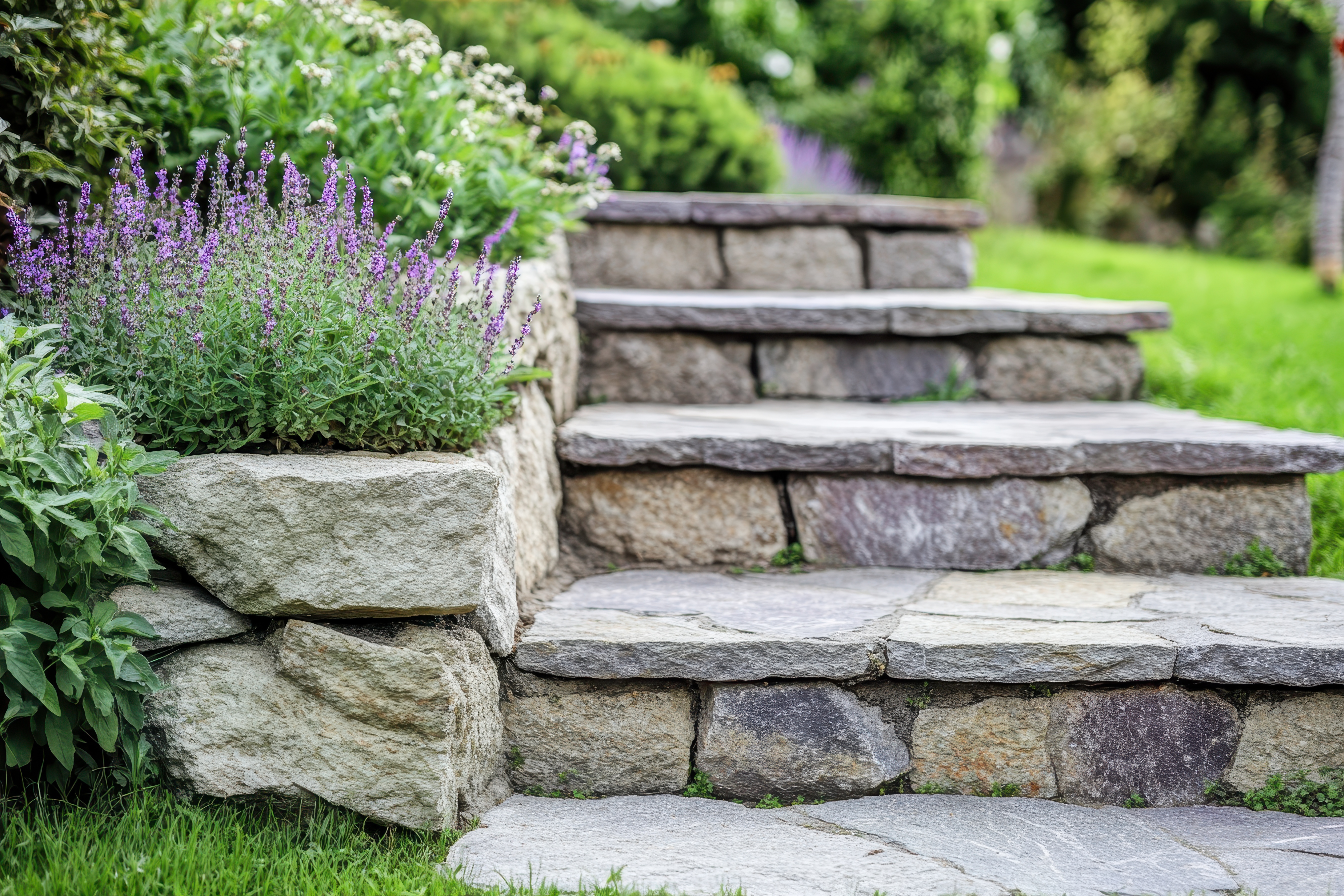
When a site’s elevation shifts significantly, embedding a stairway into a retaining wall is both a practical and elegant solution. We typically design steps to align with the wall’s material—cast concrete treads for a block wall, or quarried stone for a natural look—ensuring a seamless transition. Structurally, the stairs require a stable base; we pour a 4-inch concrete slab beneath, reinforced with rebar, and tie it into the wall’s footing to prevent settling. Step dimensions matter: aim for a 6-inch rise and 12- to 15-inch tread depth for comfort and safety. For a recent project, we flanked a stairway with low walls on either side, planting creeping thyme in the joints to soften the edges. This not only connects disparate levels—like a deck to a lawn—but also adds a sculptural element that draws the eye upward.
#4 Create a Living Wall
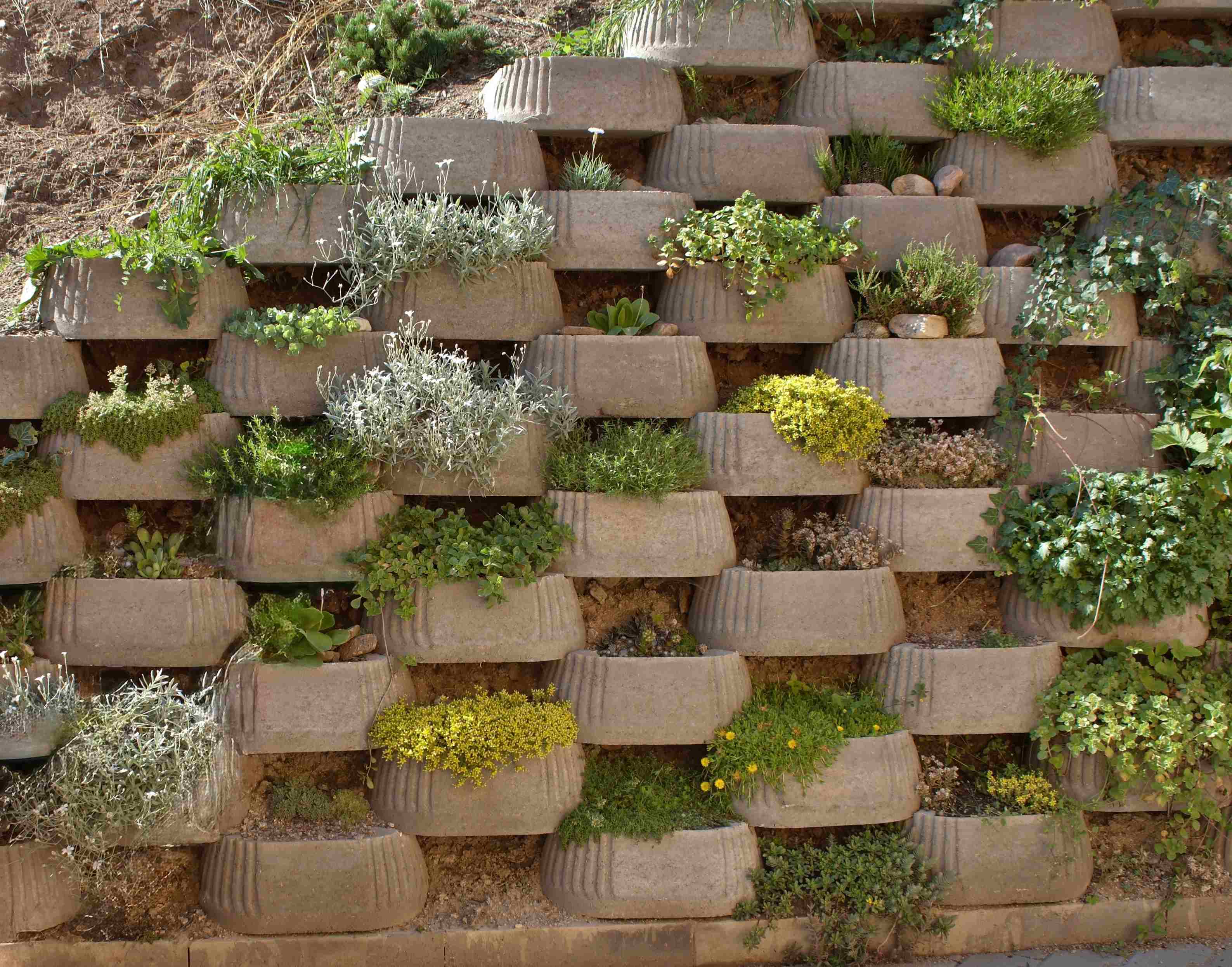
A living wall is a standout choice for clients seeking sustainability and bold design. This involves integrating planting pockets into the wall’s face—either through pre-cast modular units or custom-built recesses in a stone or concrete structure. We spec a lightweight growing medium (like a peat-perlite blend) to reduce load, and install a drip irrigation line with emitters spaced every 12 inches to ensure even moisture. Plant selection is critical: succulents like sedum thrive in shallow soil, while ferns or hostas suit shadier spots with deeper pockets. For a 10-foot-wide wall we designed last year, we used cascading vinca to create a green curtain effect, reducing heat reflection and boosting biodiversity. Structurally, reinforce the wall with geogrid fabric every 2 feet of height to handle the added weight of soil and plants. It’s a living artwork that evolves with the seasons.
#5 Integrate a Water Fountain
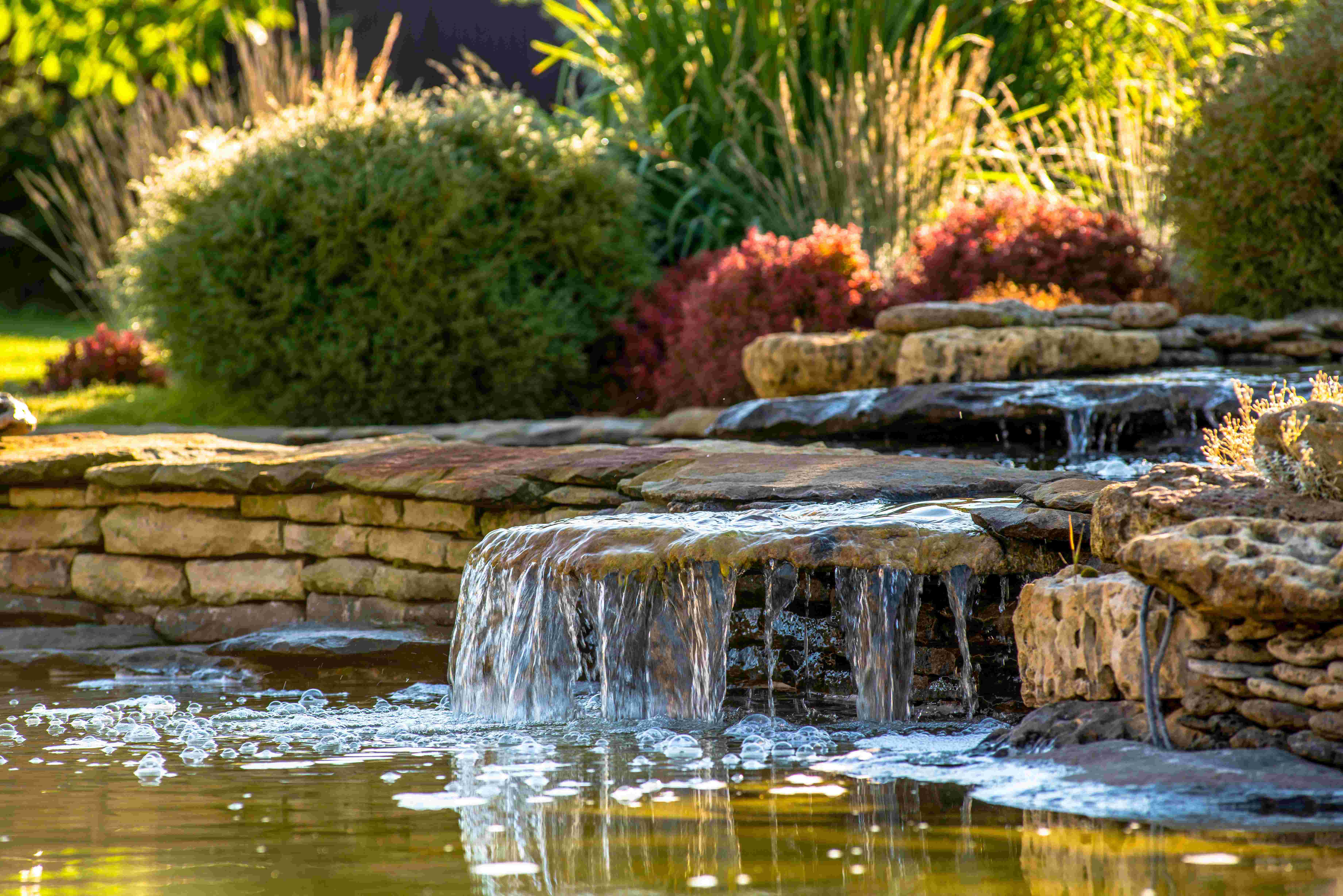
For a touch of luxury, we often recommend incorporating a water fountain into a retaining wall. This requires careful planning: carve a 6- to 12-inch-deep recess into the wall, lined with a waterproof basin at the base to catch runoff. We prefer a submersible pump (sized to the wall’s height—300 GPH for a 4-foot drop) feeding a copper or stainless steel spout for durability and a clean look. The wall itself needs extra reinforcement—double the rebar in the footing—and a hidden drainage line to manage overflow. One project featured a 6-foot slate wall with water sheeting down into a pebble-lined basin; paired with uplighting, it became a nighttime focal point. The soothing sound masks ambient noise, making this ideal for courtyards or entertaining areas. Just ensure regular pump maintenance to keep it flowing smoothly.
Honorable Mentions: Small Retaining Wall Ideas
Not every landscape demands a towering wall, and small-scale designs can be just as impactful. A 10- to 14-inch-high wall, built with dry-stacked stone or segmental blocks, can define a patio edge or circle a mature tree, creating a subtle raised bed. Supreme Landscaping advises a 4-inch gravel base for stability and a slight batter (tilt) to resist frost heave. These petite walls are quick to install—often a weekend project—and budget-friendly, yet they add polish and structure to modest spaces. For drainage, a thin layer of pea gravel behind the wall suffices.
Honorable Mentions: Sloped Backyard & Frontyard Ideas
Sloped properties are a landscape architect’s playground. In backyards, we’ll design a curved retaining wall—say, 3 feet high—to carve out a level terrace for a fire pit or dining area. This requires a deep footing (12 inches minimum) and geogrid reinforcement every 18 inches vertically to counter lateral soil pressure. Up front, a 2- to 3-foot wall along the driveway or entry path boosts curb appeal; I’ve used sleek, honed concrete blocks here for a modern edge. For both, drainage is non-negotiable: install a perforated pipe at the base, backfilled with 12 inches of crushed stone, and slope it to daylight. These walls tame the slope while unlocking its potential.
These five retaining wall ideas, plus the bonus considerations, offer a starting point for reimagining your outdoor space in 2025. Each can be tailored to your property’s specific conditions and your personal taste. If you’re ready to refine your landscape, think about which of these aligns with your goals—functionality, beauty, or a bit of both—and let’s bring it to life.

